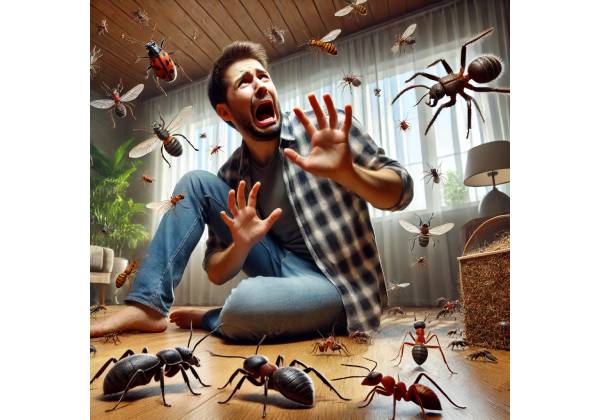What is entomophobia?
Entomophobia, or insect phobia, is a persistent, intense, and irrational fear of insects. While it is natural for people to dislike or find certain insects unpleasant, entomophobia extends beyond mere discomfort. Individuals with this phobia experience intense anxiety, panic, or distress when they encounter insects or even think about them. This fear can apply to a wide range of insects, including ants, spiders, cockroaches, flies, bees, and moths. The condition could also include a fear of being stung or bitten.
Entomophobia can severely disrupt a person’s daily life, causing avoidance of outdoor activities, reluctance to enter certain environments, and even travel restrictions. Individuals who live in areas with a high insect population, such as rural or tropical areas, may find the phobia especially difficult. Although some fear of insects may be based on legitimate health or safety concerns, such as the risk of insect-borne diseases, the phobic response is disproportionate to the actual threat posed by most insects.
Living with entomophobia can be isolating, and it may prevent people from participating in everyday activities like gardening, camping, or simply walking outside. The good news is that entomophobia is treatable; with the right interventions, people can learn to effectively manage their fears and regain control of their lives.
Symptoms of Entomophobia
Entomophobia symptoms can manifest in a variety of ways, and they frequently include both physical and emotional responses. These symptoms are triggered by the presence of insects, the prospect of encountering them, or even images and sounds related to bugs.
Physical Symptoms
The physical symptoms of entomophobia are usually caused by the body’s fight-or-flight response, which is activated when the individual perceives a threat, even if it is relatively harmless. Typical physical symptoms include:
- Rapid Heart Rate: When people encounter or think about insects, their hearts often race or pound.
- Shortness of Breath: Fear can cause difficulty breathing or a sense of tightness in the chest, which can feel overwhelming.
- Sweating: Excessive sweating, particularly in the hands and face, is a common response to insect-induced anxiety.
- Trembling or Shaking: Many people experience visible trembling or shaking when they come into contact with an insect or anticipate encountering one.
- Nausea or Stomach Discomfort: When exposed to a phobic trigger, some people may experience nausea or stomach discomfort.
- Dizziness or Fainting: Severe anxiety can cause dizziness or feelings of lightheadedness, which can progress to a full-fledged panic attack.
- Panic Attacks: In severe cases, fear of insects can cause a panic attack, which includes symptoms such as hyperventilation, chest pain, and an overwhelming sense of terror.
Emotional Symptoms
Entomophobia can have a strong emotional impact, leading to feelings of distress, fear, and hopelessness. Emotional symptoms could include:
- Intense Fear or Terror: When confronted with insects, people may feel an overwhelming sense of fear that is uncontrollable.
- Anticipatory Anxiety: Many people who are entomophobic feel anxious before they even see insects. For example, they may be excessively concerned about encountering bugs at an upcoming outdoor event or trip.
- Embarrassment or Shame: Some people may be ashamed of their fear, especially if it interferes with their social obligations or causes them to avoid certain situations.
- Frustration: Being unable to control or manage an insect phobia can cause feelings of frustration or helplessness, especially if it interferes with daily life.
Behavioral Symptoms
Individuals with entomophobia frequently exhibit behavioral symptoms as they take precautions to avoid potential interactions with insects. These behaviors may significantly disrupt normal activities. Common behaviors are:
- Avoidance of Outdoor Activities: People who have entomophobia may avoid going outside, especially in places where insects are more common, such as parks, gardens, or rural areas.
- Compulsive Cleaning or Checking: Some people may engage in excessive cleaning or pest control measures in an attempt to keep their environment insect-free.
- Avoidance of Specific Foods: In some cases, people with entomophobia avoid foods or beverages that may attract insects, such as sweet drinks, fruits, or foods commonly consumed outside.
- Social Isolation: Avoiding social gatherings or events, particularly those held outside, can result in isolation and loneliness.
- Over-Preparation: People may over-prepare for outings or trips by researching insect populations or bringing bug sprays, repellents, or protective clothing to reduce their chances of encountering insects.
Causes and Risk Factors for Entomophobia
Entomophobia is a complex condition that can be caused by a variety of psychological, environmental, and genetic factors. Understanding these causes can assist individuals and clinicians in devising effective treatment strategies.
Psychological Causes
- Traumatic Experiences: A previous traumatic event involving insects, such as being bitten, stung, or swarmed, can cause the development of entomophobia. For example, a child who received a painful bee sting may develop an exaggerated fear of all flying insects.
- Conditioning: Entomophobia can result from classical conditioning, in which a person associates insects with negative outcomes. For example, if someone had a panic attack after seeing a cockroach, they may come to associate insects with anxiety and fear.
- Other Anxiety Disorders: People with generalized anxiety disorder (GAD) or obsessive-compulsive disorder (OCD) are more likely to develop entomophobia. The fear of insects may coexist with other fears about health, safety, or cleanliness.
Environmental Factors
- Cultural Influence: Cultural beliefs and attitudes toward insects may contribute to the development of entomophobia. Certain insects are viewed as symbols of danger, disease, or contamination in some cultures, contributing to an increased fear response.
- Media Exposure: Graphic depictions of insects in the media, particularly horror films, documentaries, and news reports, can heighten people’s fear of insects. People who are exposed to negative portrayals of bugs may develop a phobic reaction.
Biological and Genetic Factors
- Genetic Predisposition: Studies indicate that people with a family history of anxiety disorders or specific phobias are more likely to develop entomophobia. Genetic factors may influence how the brain processes fear and anxiety, making certain people more prone to phobias.
- Neurochemical Imbalances: Imbalances in neurotransmitters such as serotonin and dopamine may alter how the brain regulates fear responses, increasing the risk of developing specific phobias such as entomophobia.
How Is Entomophobia Diagnosed?
Entomophobia is typically diagnosed following a thorough evaluation by a mental health professional, such as a psychologist or psychiatrist. This assessment aids in determining the severity of the phobia and the most effective treatment options.
Clinical Evaluation
During the clinical evaluation, the mental health provider will ask about the individual’s experiences with insects, their level of fear, and any avoidance behaviors. The clinician may also investigate whether other anxiety disorders or mental health conditions exist.
Symptom Assessment
To determine the severity of entomophobia, the clinician will look at the patient’s physical, emotional, and behavioral responses to insects. Standardized questionnaires, such as the Fear Survey Schedule (FSS) or the Specific Phobia Questionnaire, may be used to assess the phobia’s severity.
DSM-5 Criteria
To confirm a diagnosis of entomophobia, the clinician will compare the patient’s symptoms to the criteria for specific phobias outlined in the **Diagnostic and Statistical Manual of Mental Disorders (DSM-5). The DSM-5 criteria include the following:
- A persistent, excessive fear of insects that lasts six months or longer.
- The phobia causes significant distress or disrupts the individual’s daily life, resulting in avoidance behaviors or social withdrawal.
- The fear response is disproportionate to the actual threat posed by the insects, and the individual understands that their fear is irrational.
Treatment Alternatives for Entomophobia
Several treatment options have been shown to be effective in helping people manage and overcome their entomophobia. These treatments are aimed at reducing anxiety, desensitizing the individual to insects, and teaching practical coping strategies for managing their fear.
Cognitive-Behavioral Therapy (CBT)
Cognitive Behavioral Therapy (CBT) is a highly effective treatment for specific phobias, including entomophobia. Individuals can use cognitive behavioral therapy to identify and challenge irrational thoughts about insects, replacing them with more balanced, realistic beliefs.
- Cognitive Restructuring: In CBT, the therapist helps the individual examine their negative thoughts about insects and challenge the assumptions that underpin them. For example, someone may believe that “all bugs are dangerous,” and CBT can help them view insects more rationally.
- Exposure Therapy: Exposure therapy is an important part of CBT for entomophobia. This entails gradually and methodically exposing the person to insects in a controlled setting. Exposure can begin with pictures or videos of insects and progress to in-person encounters. Over time, this helps the person become desensitized to their fear.
- Developing Coping Mechanisms: CBT teaches people practical coping strategies, such as deep breathing, mindfulness, or progressive muscle relaxation, to help them deal with anxiety in situations involving insects.
Acceptance and Commitment Therapy (ACT)
Acceptance and Commitment Therapy (ACT) is an alternative approach to treating entomophobia that focuses on accepting the anxiety rather than trying to eliminate it completely. ACT encourages people to acknowledge their fears while committing to behavior changes that are consistent with their values, even when they are anxious.
- Mindfulness and Acceptance: ACT teaches mindfulness strategies that enable people to stay present and observe their fear of insects without becoming overwhelmed by it. This allows them to feel their anxiety without engaging in avoidance behaviors.
- Values-Based Action: Rather than allowing fear to dictate behavior, ACT assists individuals in making decisions based on their core values. For example, if someone enjoys spending time outside but avoids it due to a fear of insects, ACT can help them gradually engage in outdoor activities while acknowledging the presence of anxiety.
Medications
In some cases, medication may be prescribed to help manage entomophobia symptoms, especially if they cause severe distress and interfere with daily life. Medication is typically used in conjunction with therapy to provide temporary anxiety relief and allow the patient to participate more fully in treatment.
- Selective Serotonin Reuptake Inhibitors (SSRIs): SSRIs like fluoxetine or sertraline are commonly used to treat anxiety disorders. These medications help regulate serotonin levels in the brain, lowering overall anxiety and making it easier to manage phobias.
- Benzodiazepines: Benzodiazepines, such as lorazepam or diazepam, may be prescribed for short-term use in anxiety-provoking situations. These medications are quick-acting and can help with panic symptoms, but they are usually used sparingly due to the risk of dependence.
VRET (Virtual Reality Exposure Therapy)
Virtual Reality Exposure Therapy (VRET) is an innovative treatment for entomophobia. VRET simulates insect encounters in a safe, controlled environment, allowing people to confront their fears without risking their lives.
- Immersive Exposure: In VRET, participants are exposed to virtual representations of insects at increasing intensities. This allows them to feel their fear in a gradual, manageable manner, reducing anxiety over time.
- Safe Environment: Because VRET takes place in a virtual environment, people can practice confronting their fears without risking physical exposure to insects. This makes it an appealing option for people who are too afraid to try traditional exposure therapy.
Hypnetherapy
Hypnotherapy can be used as an additional treatment for entomophobia. During a hypnotherapy session, the individual is guided into a deep state of relaxation, which allows them to be more open to suggestion and explore the underlying causes of their fear.
- Relaxation Techniques: Hypnotherapy frequently includes guided relaxation exercises to help the individual access their subconscious mind and address the source of their fear. They may be able to reduce their anxiety by reframing their insect-related thoughts in a calm, focused manner.
Self-help Strategies
In addition to professional treatment, people suffering from entomophobia can use self-help strategies to manage their anxiety and reduce the phobia’s impact on their daily lives.
- Gradual Exposure: Exposing oneself to insects in a controlled, low-pressure environment can help to desensitize the fear over time. This could involve starting with small, non-threatening insects and gradually progressing to more difficult encounters.
- Relaxation Exercises: Deep breathing, meditation, and progressive muscle relaxation can all help reduce anxiety and make dealing with insects easier.
- Education and Knowledge: Understanding insects and their role in the environment can help alleviate irrational fears. Understanding that most insects are harmless and beneficial can change an individual’s perspective and reduce their fear response.
Long-term Outlook
Most people suffering from entomophobia can make significant progress in managing their fear by combining therapy, self-help strategies, and, in some cases, medication. While complete eradication of the phobia is not always possible, treatment can help reduce the severity of symptoms and allow people to live more fulfilling lives. Long-term success is frequently dependent on consistent attendance at therapy and gradual exposure to the feared stimulus.

















